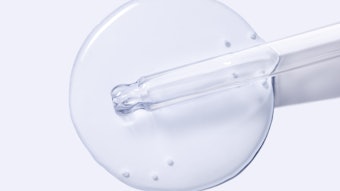Q. Now that so many companies are removing parabens from their products, I’m seeing another preservative—methylisothiazolinone—used as a substitute. Isn’t this ingredient dangerous if used in leave-on products? Why are companies using this preservative?
A. Methylisothiazolinone (MIT) is a highly effective broad-spectrum preservative that can strongly inhibit the growth of many dangerous forms of bacteria and other microorganisms that grow in unpreserved cosmetic products. It’s also used for the same reasons in adhesives, wall paint, wallpaper glue, coatings, fuels, resins, wood products, oil field operations, water cooling systems, industrial process waters and air washer systems, as well as a pesticide to control slime-forming bacteria and algae in pulp and paper mills.
Companies formulating cosmetic products for a global market are attracted to MIT because they don’t have to reformulate their products when selling throughout a variety of countries. That’s because regulatory authorities in the United States, Japan, the European Union and 25 other countries have reviewed MIT’s human allergen and irritancy studies, as well as an extensive toxicological database that includes carcinogenicity, mutagenicity and other toxicity tests, and concluded that the ingredient is safe as used in cosmetics. In fact, studies show MIT does not pose any fetal or reproductive risk to humans or other animals, nor does it cause cancer or tumor formation.1
MIT’s recommended use levels are 50–100 parts per million (ppm),2 or less than two drops per gallon of product. Levels of 1,000 ppm or higher can pose allergen and irritation risks, so some countries restrict MIT use to 50–100 ppm. Unlike other popular nonparaben preservatives, such as imidazolindinyl urea, diazolidinyl urea and DMDM hydantoin, MIT does not release formaldehyde, a known allergen, as it works to preserve a product. It’s also compatible with a variety of ingredients in a wide pH range—pH 2 to pH 9—and will not discolor products.
Environmentally, MIT is one of the most studied of all cosmetic preservatives. When it enters the environment via wastewater or other methods, it is known to rapidly degrade to a metabolite state featuring minimal toxicity, so it doesn’t bioaccumulate in ecological systems and, therefore, does not persist in the environment.2 Unlike parabens and more than 8,000 other endocrine disrupting (ED) chemicals in the environment, MIT is not ED, so it won’t mimic estrogens, cause reproductive harm or interrupt the hormonal functions of fish, frogs or other organisms, including humans.
Cost-wise, because MIT is effective in extremely low quantities, it can replace parabens in a formula for pretty much the same price. Other preservative systems currently being reviewed as paraben replacements can more than double the price of the base formula—clearly not viable substitutes for today’s price-conscious consumer.
Some of these preservative options can also pose the risk of discoloration and unwanted interactions with other ingredients, as well as ecotoxicity, human toxicity and endocrine disruption in humans and other animals. To this, add higher use levels, pH restrictions, lack of worldwide approval, and sometimes unknown or limited toxicological data, and it’s easy to see why so many companies are choosing MIT instead of other preservative options as their primary paraben replacement.
So, what’s the downside of MIT? Used in cosmetics since the 1970s, MIT was part of a duo with a chlorinated compound as a partner—methylchloroisothiazolinone (CMIT). The two were known for years under the trade name Kathon CGTM from Rohm and Haas. When used at levels 10 times higher than those recommended for cosmetics, both preservatives are known to irritate the skin and increase the risk of allergy, and both are corrosive to the skin and eyes in their concentrated form. Not realizing the strength of these preservatives, many chemists used them at the same levels as parabens and formaldehyde-releasing preservatives when they were first introduced in the 1980s. Since traditional preservatives are used at almost 100 times the percentage of Kathon CGTM, an epidemic of consumers reported allergies and irritated skin after using products containing the blend. Although this occurred more than 20 years ago, Kathon CGTM’s reputation as a problem ingredient became widely known, even though lower use levels were finally understood in the 1990s.
Today, because chemists have learned to work with Kathon CGTM, many countries now allow the blend in leave-on products. The key is to make sure only 8 ppm is used. For rinse-off products, such as facial cleansers, body washes, shampoos and conditioners, the level is slightly higher at 15 ppm. According to a representative at Rohm and Haas, now that the blend is being used at the proper levels, it has the same amount of low-allergy risk as other popular preservatives on the market.
During that 20-year period, researchers have also been able to identify CMIT, the chlorinated version of the molecule, as posing more allergy and irritation potential than MIT, the nonchlorinated molecule. Because the names are so close and the two were linked in dermatological, toxicological and ecological studies for almost four decades, many people still paint MIT with the same brush as CMIT.
This doesn’t mean MIT is without its problems. When humans are exposed to much higher levels of MIT than those used in cosmetics, it demonstrates moderate-to-high acute toxicity in oral, dermal and eye irritation and inhalation acute toxicity studies, according to the Environmental Protection Agency (EPA). Although this poses no risk for cosmetics consumers or esthetic professionals who are exposed to MIT in the tiny quantities used in makeup, manufacturer employees who weigh or add the material to cosmetics and other products, or who work with it at high concentrations in industrial applications, must wear protective gear to remove the risks MIT can pose. According to the EPA, the worst case scenario for people exposed to MIT-treated products is for those working with paint applications—risk exposure to cosmetics is not even addressed.1

The University of Pittsburgh researchers are clear to point out they cannot show a link between MIT and neurological disorders in humans and other animals. Nor has any link ever been shown between neurological problems in the brain or peripheral nerves found in the skin, even though MIT has been studied in detailed clinical observations, motor-activity measurements, and examinations of body tissues in the central nervous system and peripheral nerves.
Clearly, the results of the rat-brain neuron studies have no relevance when MIT is applied to human skin in cosmetics. Even so, the Environmental Working Group’s (EWG) Skin Deep Cosmetic Safety Database gives MIT a score of six, identifying it as a “moderate hazard” in cosmetics. This rating is due to the following.
1. Violations, Restrictions and Warnings. Use levels of MIT in cosmetics are restricted to 50–100 ppm in the European Union, Canada, Japan and as suggested by the Cosmetic Ingredient Review in the United States. This restriction ensures that cosmetic chemists stay well within the safety zone of this ingredient when they formulate new products.
2. Human Skin Toxicant, Immunotoxicity. When used more than 1,000 ppm—10–20 times more than allowed levels—risk of allergy and irritation increases. In the EWG database, these reactions are summarized under the phrases “human skin toxicant” and “immune system toxicity.”
3. Neurotoxicity. The two studies by neurobiologists at the University of Pittsburgh show dose-dependant exposure to MIT is neurotoxic to rat brain cells in culture. No link has ever shown that MIT causes neurological disorders in animals or humans, even though the ingredient has been extensively researched.
Unfortunately, consumers eager for information about cosmetic ingredients will see the EWG database when they conduct a search of MIT on the Internet. Because they will read such alarming statements as “human skin toxicant,” “immunotoxicity,” “neurotoxicity,” and “violations, restrictions and warnings,” they will be justifiably concerned for their health and safety. So, show them this report if they ask you why MIT is in your products. Just like you, they deserve to know the whole truth about this ingredient.
REFERENCES
1. R.E.D. FACTS: Methylisothiazolinone. EPA-738-F-98-008, Oct 1998
2. Neolone data report, Rohm and Haas
3. S Du, B McLaughlin, S Pal and E Aizenman, In vitro neurotoxicity of methylisothiazolinone, a commonly used industrial and household biocide, proceeds via a zinc and extracellular signal-regulated kinase mitogen-activated protein kinase-dependent pathway. J Neurosci, 22(17), 7408–7416 (Sept 1, 2002)
4. K He, J Huang, CF Lagenaur and E Aizenman, Methylisothiazolinone, a neurotoxic biocide, disrupts the association of Src family tyrosine kinases with focal adhesion kinase in developing cortical neurons.
J Pharmacol Exp Therap, 317, 1320–1329 (2006)
Archived webinar:
Cutting-edge Ingredients 2008 by Rebecca James Gadberry (February 12, 2008)
Q & A from Cutting-edge Ingredients 2008 webinar with Rebecca James Gadberry (February 12, 2008)
Recent Ingredient Review columns:
Ingredient Review: The Truth About Chemicals, Mineral Oil, Squalene and Fillers by Rebecca James Gadberry (April 2007)
Recent news items regarding parabens and preservatives:
Study Reports Consumer Attachment to Naturals/Organics (January 22, 2008)
Growth for Naturals (September 24, 2007)










